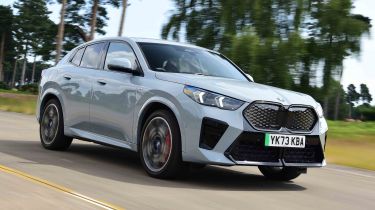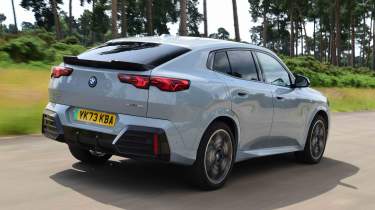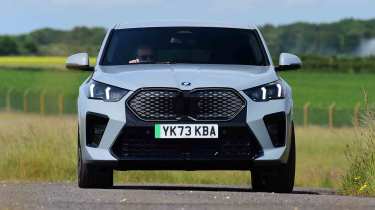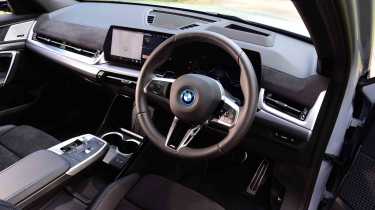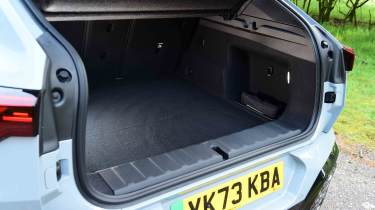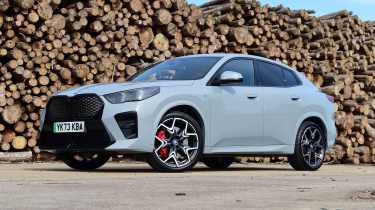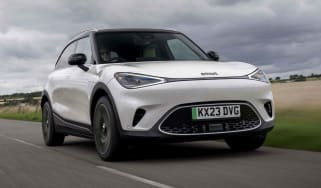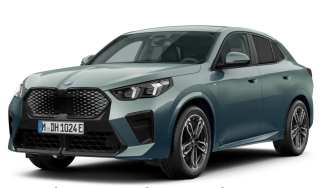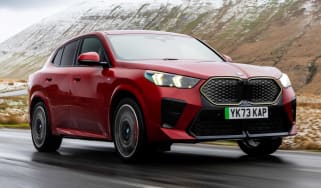BMW iX2 review
The BMW iX2 electric SUV has styling on its side, but is less appealing than the impressive iX1

Is the BMW iX2 a good car?
Unless you’re sold on its looks, it’s hard to find the BMW iX2 anything but less appealing than its close relation, the BMW iX1. The coupé-SUV’s ride quality is every bit as firm as the regular model’s, and there’s less headroom in the rear cabin to boot. The four-wheel-drive iX2 is a bit too fast for its own good too; the more modest front-drive edition might actually prove better to drive overall, as well as offering cost savings and extra electric range.
| Key specs | |
| Fuel type | Electric |
| Body style | Five-door coupe-SUV |
| Powertrain | 64.8kWh battery, 1x e-motor (eDrive20) front-wheel drive 64.8kWh battery, 2x e-motor (xDrive30) four-wheel drive |
| Safety | 5-star (results of the BMW X2, Euro NCAP 2024) |
| Warranty | 3yrs/unlimited miles |
How much does the BMW iX2 cost?
The entry-level 204PS eDrive20 model range starts from just over £51,500, which is a smidgen more than what you’d pay for a bells-and-whistles X2 M35i petrol model; electric cars (and their batteries) still don’t come cheap, it seems.
Opt for the xDrive30 with its dual motors and 313PS output, and your starting figure is nearly £57,500, six grand more than the eDrive 20, and an awful lot to pay for a vehicle that is based on the same underpinnings as much of the MINI range. The mechanically similar MINI Countryman, for comparison, starts at just over £42,000, while all-wheel drive models with the same power output as the iX2 xDrive30 start at about £47,000.
Both iX2 versions come only in M Sport trim, which brings a fair amount of standard equipment. You get 19-inch alloy wheels, power folding mirrors, Alcantara upholstery, heated front sports seats, a powered tailgate, air conditioning, a 10.25-inch digital instrument panel and high-gloss exterior trim elements.
Electric motors, performance & drive
For those who want their electric coupe SUV to deliver sporting straight line speed to match the looks, there’s the iX2 xDrive30. It has dual motors – one on each axle – producing a combined 309bhp and 494Nm of torque, making this a car with prodigious performance (0-62mph takes 5.6 seconds, only a whisker longer than the BMW X2 M35i).
Used - available now

2026 BMW
iX2
15,690 milesAutomaticElectric
Cash £29,333Flick the simple toggle gear selector into D to pull away, and you’ll be impressed by the smooth power delivery and excellent electric motor refinement. There’s a firm edge to the suspension at lower speeds – an early reminder that BMW’s engineers have had to set the chassis to cope with a 2.1-tonne vehicle.
Sadly, that impression of mass is something that the iX2 struggles to shake, something you might be forgiven for expecting because a BMW is supposed to deliver more involvement than you’d find in its rivals. There’s instant punch alright – enough for the iX2 to feel rapid when joining a motorway or squirting between corners – but equally, the car never quite feels like one with more than 300bhp and almost 500Nm of torque.
The ride never quite settles, unfortunately. What seems to have been an overriding focus is keeping the body flat at a fast cruise (tip: think autobahns), resulting in a stiff primary set-up that no amount of softened-off damping can overcome. Indeed, chuck the iX2 around on a bumpy road, and you’ll find that it struggles to get out of its own way as the car fights to compose itself between changes of direction. The steering is consistently weighty but devoid of feedback, and if you do lose patience and hurl the iX2 at a corner, the front end will just slide across the Tarmac in an armful of understeer.
The weird thing is that it’s never genuinely uncomfortable and feels tied down in most scenarios, really. Yet we can’t help but sense that a little more compliance, while resulting in a teeny bit more body lean, would have delivered a more composed performance overall.
The best environment is motorways, where the aforementioned motor refinement is joined by good wind-noise suppression to deliver a restrained cruise.
| Model | Power | 0-62mph | Top speed |
| iX2 eDrive20 | 204 | 8.6 seconds | 106mph |
| iX2 xDrive30 | 313 | 5.6 seconds | 112mph |
Range, charging & running costs
The BMW iX2 range starts with the eDrive20, which has a single front-mounted motor producing 201bhp and 250Nm of torque, and a 64.8kWh (net) battery that’s good, BMW claims, for a range of between 272 and 283 miles of range – with rapid recharges at up to 130kW – so a 10 to 80 per cent top-up should take around half an hour.
The battery capacity of the more powerful and expensive dual-motor xDrive30 remains the same as that of the eDrive20, so you pay a price in range for this extra pace; it drops to between 259 and 266 miles, depending on specification.
Compare the battery capacity and range figures, and the iX2 should be capable of about 4.3 miles per kilowatt hour at its most efficient in eDrive20 form, and as little as 4.0 mi/kWh in the less efficient xDrive30 specs. In brisk driving, our xDrive30 returned around 3.0mi/kWh, which would equate to a range of about 195 miles, though most owners will likely find themselves somewhere between this lower limit and the claimed figures – a real-world 3.5 mi/kWh and 220-230 miles or so from full to empty.
A full charge on a home 7.4kW wallbox at 9p/kWh overnight would cost you just under £6, while that 10-80 per cent fast charge, for around 45kWh of electricity and at 75p/kWh, is more like £34. At 3.5 mi/kWh, that £34 would get you around 160 miles.
The iX2’s spread of insurance groups from 31-38 is similar to the more practical iX1, and similar to its Audi Q4 e-tron rival, but all should cost you less to insure than the Mercedes EQA, which is in groups 37-45. A three-year, unlimited mileage manufacturer’s warranty should provide some peace of mind for buyers, but it’s far from being the best warranty on the market, with the likes of Hyundai, Kia, and Toyota all offering you much longer coverage. The battery pack is covered by a separate 8-year/100,000-mile warranty, which is typical for an EV.
| Model | Battery size | Range | Insurance group |
| iX2 eDrive20 | 64.8kWh | 266 miles | 31E |
| iX2 xDrive30 | 64.8kWh | 283 miles | 38E |
Design, interior & technology
With the more sensible iX1 already in the lineup, the iX2 is deliberately aimed at those who may not need as much practicality, and can sacrifice some of the iX1’s utility for visual flash.
The iX2 is longer than the previous generation X2 by a full 194mm, and has a much more sloping roofline, so despite a 64mm increase in ride height, it’s considerably more rakish and hides its familiar underpinnings (it shares its platform with everything from the BMW 1 Series to the MINI Countryman) quite effectively.
The front end is similar to the iX1, but around the back the iX2 has its own style. A busy one, it has to be said, but it’s certainly a car with more personality than the old X2 and puts much more distance between itself and the iX1 than the old X1/X2. You can stand out further by opting for one of the more vibrant paint shades, such as Fire Red, Portimao Blue, or the satin-finish Frozen Portimao Blue, and BMW’s Individual programme gives you dozens more options; several of the launch cars were painted in a Kermit-hued Frozen Tampa Bay Green Metallic.
Climb aboard, and the first thing that strikes you about the iX2’s cabin is that its finish is on a completely different level from the first generation X2. There are perhaps a few too many textures visible on the dashboard – a diamond pattern on the top and a swirly line across the metallic front panel, for example – but there’s no faulting the materials or the quality of the switches. It feels like a £50k car – just as it should. There’s a wide choice of interior trim materials too, including real leather and Veganza artificial leather (some offered in brown, grey, beige, red, or black colourways).
There are also useful cubbies in the front, including a tilted wireless charging panel for smartphones, and a couple of USB-C ports lurk behind the twin cup holders.
Sat-nav, stereo and infotainment
Like other recent BMWs, and in common with smaller models like the 1 Series, the iX2 gets a curved twin-screen display in front of the driver, for both driving information (10.25 inches) and infotainment (10.7 inches) needs. What you don’t get, which some larger BMWs have retained, is an iDrive control knob in the centre console for operating some functions with a physical control, so everything is now loaded into the touchscreen.
The in-car tech would be better without this heavy reliance on touchscreen controls, but there are at least sensibly placed, permanent shortcuts on display for the heating, ventilation, and the heated seats. The system itself is typical BMW – so responses are snappy (it runs on the company’s ninth-generation operating system), and there’s already a decent range of third-party apps that you can add (podcasts and music) to enjoy on the move or, in the case of movie streaming and gaming, while parked up at a charging station.
There are clever touches, such as the little rollercoaster-style bar that holds your phone in place while you’re driving on the relatively upright wireless charging pad. Naturally, Apple CarPlay and Android Auto are both supported, too.
Boot space, comfort & practicality
You shouldn’t, and probably wouldn’t, expect the same kind of practicality from the iX2 that you’d get from the iX1 on account of its sloping roofline. The coupé body style does little for the rear cabin, where you’ll find a respectable amount of leg and kneeroom for six-footers, but restricted headroom for anyone that height. It can also feel pretty gloomy back there since the rear screen is quite far away and very sloped. The side windows narrow as they go towards the back of the car, restricting light further.
At least the boot is a decent size, at 525 litres, which is larger even than the iX1 – and while the floor isn’t a true variable-height affair, it is hinged close to the rear seat backs, so it lifts up easily, and stays in place when you want to throw cables into the underfloor storage compartment. The low roofline won’t be dog-friendly, but luggage isn’t much of a problem. The rear seat backs are split 40/20/40 and can be folded forwards to expand the boot volume to 1,400 litres.
Things are much better overall up front though. It’s lighter and airier than in the back, and we’ve already gone over the quality and layout, which both comfortably justify the iX2’s reasonably high price. As is typical for a BMW, the driving position is excellent. The seats are comfortable, all the major controls are well-aligned, and the seat and wheel both offer enough adjustment that only weird alienesque creatures are unlikely to find the ideal combination.
| Dimensions | |
| Length | 4,554mm |
| Width | 1,845mm (2,104mm inc. mirrors) |
| Height | 1,560mm |
| Number of seats | 5 |
| Boot space | 525 litres (1,400 litres seats folded) |
Safety & reliability
The electric BMW iX2 hasn’t been crash tested by Euro NCAP, but the safety body has tested its petrol and diesel equivalents in X1 form, which received a full five-star rating and some particularly impressive scores for child occupant protection and safety assist features. We’d expect the iX2 to do similarly well given that, drivetrain and roof shape aside, it’s largely identical to the tested models. The high safety assist score came down to praise for the car’s various occupant reminder features, such as its lane keeping and emergency braking functionality, and its effective speed assistance functions.
Reliability is more of an unknown. Neither the X1, X2, nor its previous variants appeared in the top 100 models in the 2024 Driver Power Survey. The closest analogue was the combustion-powered BMW 1 Series, in 25th place from 100 cars, and the only car in the top 100 to share its platform with the iX2. BMW as a whole finished 14th out of 32 brands – significantly ahead of its Mercedes and Audi rivals.
| Key standard safety features | Euro NCAP safety ratings |
|
|
BMW iX2 alternatives
Coupe-style SUVs are nothing new. Indeed, the iX2 is now, electric bit aside, in its second generation, though the current model has a much more rakish profile than its predecessor. More rakish than its closest rivals too; Mercedes-Benz doesn’t even have a direct equivalent (the EQA is pretty conventional, the Mercedes EQB the boxy practical one), while the Audi Q4 Sportback e-tron doesn’t hide the visual bulk of its electric platform quite as successfully.
Elsewhere, you’re looking at models like the Volvo EC40, Ford Capri and Ford Mustang Mach-E, Skoda Enyaq Coupe, Kia EV6… essentially, quite a few coupe-style models fall within the same pricing bracket as the iX2, and those from brands that don’t quite have the premium appeal of the BMW badge tend to be a little larger and more practical, and offer you a little more for your money.
As an alternative based on the same platform, there’s the MINI Countryman. It’s similar to the BMW under the skin, and while it doesn’t have a sloping roofline, it’s hard to argue that it doesn’t have style, especially inside with its circular OLED infotainment screen and some imaginative colours and trim materials.
Frequently Asked Questions
BMW offers a three-year, unlimited mileage warranty on the iX2, which isn’t as high as some alternatives in its price bracket.
More reviews
Which Is Best
Most Economical
- Name150kW eDrive20 M Sport 65kWh 5dr Auto [22kWCh]
- Gearbox typeAuto
- RRP£50,915

